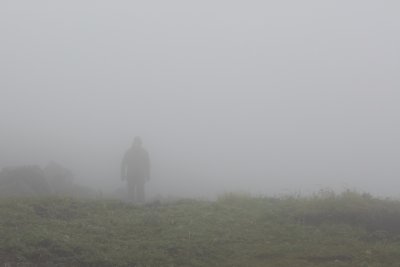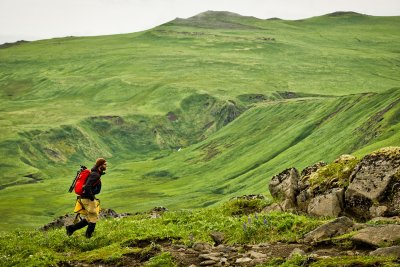‘Rafters,’ the Northwest Passage, and the Future of the Unspoiled Arctic
Western Washington University Professor of Biology Eric DeChaine is working through a three-year grant from the U.S. National Park Service’s Shared Beringian Heritage Program to document the diversity and distribution of plants across the North Pacific — including the Alaskan Peninsula, the Aleutian Islands, and Russia’s Kamchatka Peninsula— in an effort to understand how arctic plants are reacting to a planet that is growing ever warmer.
DeChaine started his field work on the project in July 2018, when he spent the summer alongside peer scientists from Russia searching for plants throughout the wild and remote Kamchatka Peninsula, sampling in a variety of habitats from sea level to the slopes of the peninsula’s many famous volcanoes.
“What an incredible place,” DeChaine said. “We got there just as spring was turning to summer, and the hills were bursting with wildflowers. The streams were full of salmon. We counted 40 brown bears in a single day; they were all there to eat the fish.”
This past summer DeChaine sampled in the Aleutian Islands, first on the remote island of Tanaga, then to Adak and Amchitka.
“Like a lot of places I sample, not much if any work has been done to establish a baseline survey of these areas, at least not in a while,” he said. “It is extra important to get this data as a couple of things happen: First, arctic environments are the first to change as the planet warms. Secondly, this warming has opened up a new potential shipping lane across the top of North America that will have a huge impact on the Aleutians.”
“These are some of the most remote places left in the world,” he said. “And at least for the time being, still very much unspoiled. This grant is an incredible opportunity to sample them.”
This shipping lane, once sought after by European explorers as the fabled “Northwest Passage,” has become more of a reality as Arctic ice pack levels continue to shrink. Large freighters have made test runs through the straights, but questions around sovereignty and international waters remain to be ironed out.
In the meantime, DeChaine says that given the rate of melt and the potential amount of shipping that is eager to use the new route, it is wise to prepare for the impact of that sea traffic now.
“Ships have historically spread flora and fauna around the globe since the age of sail,” said DeChaine. “From the seeds of invasive species to beetles and rats, these unwanted stowaways are known as ‘rafters,’ and they are inevitable,” he said.
DeChaine said the potential impact on the fragile ecosystems of an island like Adak, with its large natural harbor and sophisticated airport facilities (it is a former World War II naval air base) could be immense, which makes documenting and sampling the island now doubly important.
The third and last year of sampling for this grant will be summer 2020, and DeChaine will spend that time on Alaska’s Kodiak Island, just one more remote sampling location from a list over the last decade that includes Greenland, the Russian Far East, and paddling hundreds of miles down the Ikpikpuk River on Alaska’s North Slope.
“These are some of the most remote places left in the world,” he said. “And at least for the time being, still very much unspoiled. This grant is an incredible opportunity to sample them.”
For more information about his research, contact Eric DeChaine at eric.dechaine@wwu.edu.
Interested in researching climate change? Find out more here.

